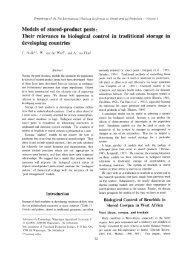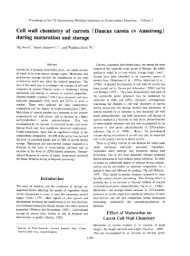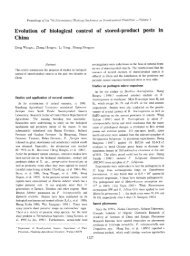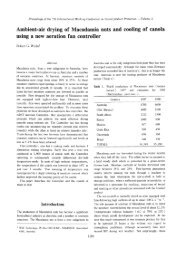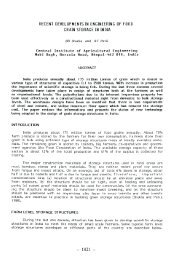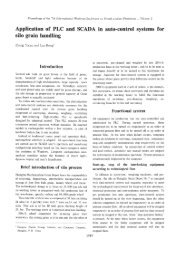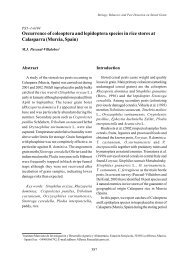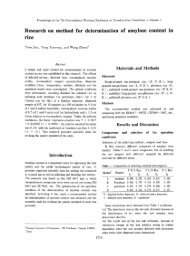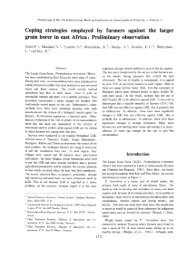Identifying Stored-Grain Insects Using Near-Infrared Spectroscopy
Identifying Stored-Grain Insects Using Near-Infrared Spectroscopy
Identifying Stored-Grain Insects Using Near-Infrared Spectroscopy
You also want an ePaper? Increase the reach of your titles
YUMPU automatically turns print PDFs into web optimized ePapers that Google loves.
166 JOURNAL OF ECONOMIC ENTOMOLOGY Vol. 92, no. 1<br />
Table 1. <strong>Stored</strong>-grain beetles (Coleoptera) used in the neural network and partial least squares analysis of NIR spectra when comparing<br />
species, genera, and primary versus secondary pests<br />
Code Common name ScientiÞc name Family<br />
FGB Flat grain beetle<br />
Secondary Pests<br />
Cryptolestes pusillus (Schönherr) Laemophloeidae<br />
RGB Rusty grain beetle Cryptolestes ferrugineus (Stephens) Laemophloeidae<br />
SGB Sawtoothed grain beetle Oryzaephilus surinamensis (L.) Silvanidae<br />
MGB Merchant grain beetle Oryzaephilus mercator (Fauvel) Silvanidae<br />
CFB Confused ßour beetle Tribolium confusum Jacquelin du Val Tenebrionidae<br />
RFB Red ßour beetle Tribolium castaneum (Herbst)<br />
Primary Pests<br />
Tenebrionidae<br />
LGB Lesser grain borer Rhyzopertha dominica (F.) Bostrichidae<br />
GB Larger grain borer Prostephanus truncatus (Horn) Bostrichidae<br />
GW Granary weevil Sitophilus granarius (L.) Curculionidae<br />
RW Rice weevil Sitophilus oryzae (L.) Curculionidae<br />
MW Maize weevil Sitophilus zeamais Motschulsky Curculionidae<br />
Materials and Methods<br />
About 20 adult insects were selected from each of<br />
11 beetle species commonly found in stored grain<br />
(Table 1). These species were obtained from stock<br />
colonies reared at 25 o C and 50Ð60% RH. Composition<br />
of laboratory diets for the different species were as<br />
follows: diets for the ßat grain beetle, Cryptolestes<br />
pusillus (Schönherr) (Coleoptera: Laemophloeidae);<br />
rusty grain beetle; sawtoothed grain beetle, Oryzaephilus<br />
surinamensis (L.) (Coleoptera: Silvanidae); and<br />
merchant grain beetle, Oryzaephilus mercator (Fauvel)<br />
(Coleoptera: Silvanidae), consisted of oatmeal:<br />
whole wheat ßour:BrewerÕs yeast:wheat germ (60:30:<br />
5:5), (vol:vol); diets for the confused ßour beetle,<br />
Tribolium confusum Jacquelin du Val (Coleoptera:<br />
Tenebrionidae), and the red ßour beetle, Tribolium<br />
castaneum (Herbst) (Coleoptera: Tenebrionidae),<br />
consisted of whole wheat ßour and BrewerÕs yeast<br />
(95:5), (vol:vol); the lesser grain borer was reared on<br />
whole wheat lightly dusted with wheat ßour; the<br />
larger grain borer, Prostephanus truncatus (Horn)<br />
(Coleoptera: Bostrichidae), and the maize weevil,<br />
Sitophilus zeamais Motschulsky (Coleoptera: Curculionidae),<br />
were reared on whole-kernel corn; and the<br />
rice weevil, Sitophilus oryzae (L.) (Coleoptera: Curculionidae),<br />
and granary weevil, Sitophilus granarius<br />
(L.) (Coleoptera: Curculionidae), were reared on<br />
hard red winter wheat.<br />
The live insects were individually placed in a black<br />
V-shaped trough (12 mm long, 10 mm wide, 5 mm<br />
deep) and illuminated with white light via a Þber<br />
bundle (8 mm diameter) positioned 13 mm from the<br />
top of the trough and oriented 45 o from vertical. A<br />
reßectance probe (2-mm diameter) was oriented vertically<br />
9.5 mm from the top of the trough. The reßectance<br />
probe carried the reßected energy to a spectrometer<br />
(DA7000, Perten Instruments, SpringÞeld,<br />
IL). The diode-array spectrometer measures visible<br />
(400Ð750 nm) and NIR (750Ð1,700 nm) reßectance at<br />
a rate of 30 spectra per second. Procedures included<br />
collecting a baseline, collecting 8 spectra from each of<br />
the insects, and averaging the 8 spectra for each insect.<br />
This resulted in spectra from 275 individual insects.<br />
Collecting and averaging the 8 spectra from each in-<br />
sect took 1 s. The baseline consisted of collecting a<br />
spectrum of the empty trough to use as a reference. A<br />
new baseline was collected after each group of 40<br />
insects.<br />
Data were analyzed using partial least squares regression<br />
(PLS) (Galactic Industries 1996) and a backpropagation<br />
neural network (NeuralWare 1995). Correlation<br />
plots (r 2 ) and factors indicating which<br />
wavelengths contribute to classiÞcations in 2-way<br />
comparisons were obtained using PLS (Murray and<br />
Williams 1990). Two-way comparisons were made using<br />
PLS by assigning a value of 1 or 2 to the comparisons<br />
of interest (for example, primary 1, secondary<br />
2).<br />
The neural network analysis gave classiÞcation percentages<br />
for all 2-way as well as higher-order comparisons<br />
(up to 11 species compared). The neural<br />
network had 1 hidden layer, 100 input nodes, and 2, 3,<br />
or 11 outputs. The 100-input nodes corresponded to<br />
the absorbance values at 10 nm increments from 700<br />
to 1,700 nm. The outputs corresponded to the comparisons<br />
being tested. The learning rate, momentum,<br />
and learning events used in the neural network were<br />
0.6, 0.4Ð0.5, and 10,000Ð30,000, respectively. The<br />
learning rate, momentum, learning events, and number<br />
of hidden layers affect the neural network accuracy<br />
and speed (Hecht-Neilsen 1989). For both the<br />
PLS and neural network analyses, even-numbered<br />
samples served as training or calibration sets, whereas<br />
odd samples were used for testing calibration models.<br />
Table 2 shows the comparisons tested. The classi-<br />
Þcation of paramount interest was primary versus secondary<br />
insects because management strategies for<br />
these 2 types of insects may be quite different and<br />
because knowing whether an insect is a primary or<br />
secondary pest is usually sufÞcient for making a management<br />
decision. In addition, insects were classed<br />
into their respective genera (2 or 3 comparisons)<br />
within the primary and secondary groupings, and<br />
classed into species within a genus (2 or 3 comparisons).<br />
A Þnal comparison sought to classify insects into<br />
their respective species independent of previous<br />
groupings (11 comparisons).




